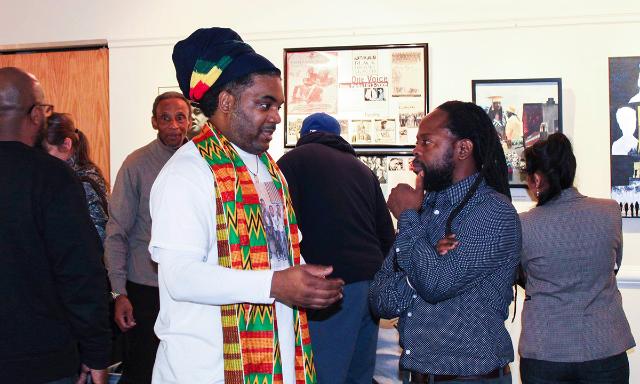"Around the College" is no longer being updated.
View current SUNY Empire Stories.
February 21, 2018
Opening Reception for Art Exhibition, “50 Years Still Dreaming,” a Complete Success
The Exhibit Honors the Legacy of Rev. Dr. Martin Luther King Jr. and Celebrates Black History Month

More than 100 visitors, faculty and staff participated in the opening reception for “Fifty Years Still Dreaming,” an art exhibition celebrating Black History Month and civil rights leader Rev. Dr. Martin Luther King Jr., who was assassinated in 1968.
Visual Arts Mentor Raúl Manzano ’05, who launched the annual event celebrating Black History Month in 2012, curated the exhibition and described it as a learning experience for SUNY Empire students studying exhibition design and curatorial studies.
“Through their work, they create venues through which they can express their creativity and voice, as well as network and promote cultural diversity,” Manzano said.
The opening reception took place Thursday evening, Feb. 8, at the Livingston Gallery, located in the college’s Brooklyn location, and was hosted by the college’s Arts and Media Department.
Members of the general public are invited to view the exhibition, free of charge, which will be on display through Monday, April 30.
Images from the opening reception are available on the college's Facebook page.
Julia Primus ’16 was the assistant curator and décor designer for the Livingston Gallery. Delicate fabrics on the windows and overhead garlands, in symbolic colors representing black culture, set the tone for the reception.
SUNY Empire student Starisha Harris documented the exhibition for her Advance Photography study with Mentor Terry Boddie, a member of the college’s faculty and a visual artist.
Robert B. Carey, a mentor and professor in Historical Studies, and member of the Empire State College Foundation Board of Directors since 2012, provided remarks.
Carey shared some memories of his friendship with King: “It was a time of enormous hope, a violent time. Nevertheless, there was a sense that that horizon was reachable and the Voting Rights Act seemed to suggest that maybe this country has crossed over. It is important for all of us not simply to celebrate the legacy, but to be connected to something, something that is working to change things for the better. Take that legacy, keep it in your pocket, find ways to make a difference and take pride.”
After Carey spoke, alumni and student artists shared their thoughts with the audience.
Student Christian Miles said, “My photojournalist images of the Black Lives Matter protest on July 7, 2016, in New York City bear witness to the outcry for justice against the systematic killing of innocent black Americans by the hands of law enforcement.”
Chris Bowman ’18 said, "My photos in “50 Years and Still Dreaming” is a window into the souls of those who are still suffering from the effects of discrimination dating back to the Civil Rights era. One could even argue as far back as the horrors of slavery."
Daisy Ferrer ’16 said, “My presentation is about the achievements of the African-American community, the struggle of slaves to survive in a society that has denied them the most basic human rights because of their skin color, the fight for social justice, equality and segregation. Dr. King’s achievements and legacy are reflected in the first elected African-American president of the United States, Barack Obama.”
Noel Hall ’83 said, “My work represents, in part, many of the hopes, challenges and never-ending hypocrisy the African-American community has faced for centuries. Yet, they remain hopeful, able to preserve and realize some accomplishments guided and encouraged by the spirits of their ancestors and the inspiring, brilliant words and deeds of Rev. Martin Luther King Jr.”
Alisa Irby ’16 said, “My photos depict Dr. King’s most difficult struggles, his civil right journeys and peaceful demonstrations. In contrast was the lynching of 19-year-old Michael Donald in Alabama in 1981, which forced America to examine the truth about Dr. King’s nonviolent message to change the legislature.”
Marvenia Knight ’12 said, “My collages, ‘Women Empowerment,’ are my vision of women coming together to end all types of discrimination. My other piece, ‘Great Migration,’ focuses on people that left the South for a better life … encouraging our youth to further their education.”
Natural Langdon ’17 said, “My photos of children are about legacy and investing in young people to fulfill the dream of Dr. Martin Luther King Jr. As a recipient, I wanted to thank all my mentors at ESC, my mother and my aunt for investing in me, and my daughter who will continue to carry on the dream of Dr. King.”
Vanessa Moore ’14 said “As a child of the ‘60s, the question if we have overcome lies in my head still. Yes, we have come a long way, but have we overcome yet? My collage fuses images from the past and present to bring that question to our consciousness.”
Assistant Curator Primus said, “My mixed-media installation piece, ‘A Ritual Table of Memories,’ invokes spiritual thinking and contemplations of secular and religious artifacts, as Dr. King’s life was guided by God and prayers to bring people together, especially people of color.”
Daryl Tyllman ’16 said, “’The ultimate measure of a man is not where he stands in moments of comfort and convenience, but where he stands at times of challenge and controversy.’ This MLK quote exemplifies Judge Glenda Hatchett’s constant desire to help the downtrodden and the underserved communities of color. In 2016, Hatchett announced her representation of (the family of) Philando Castile (who was shot and killed by a police officer in St. Anthony, Minn.) because of her concerns about police brutality for African-American men.”
In closing, Manzano encouraged all to reflect on the artists’ comments, what has transpired since King’s assassination and, if his historic 1963 “I have a dream” speech, and the “promissory note” he described, have been fulfilled.
